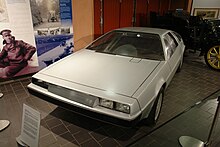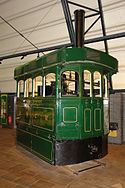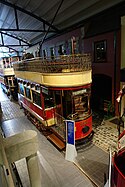Ulster Folk and Transport Museum
 Ulster Transport Museum Railway Gallery |
|
| Data | |
|---|---|
| place | Cultra near Belfast in Northern Ireland |
| Art |
Open-air and folklore museum Transport Museum |
| Number of visitors (annually) | 168,077 (2017) |
| Website | |
The Ulster Folk and Transport Museum is located in Cultra about 7 miles east of the city of Belfast in Northern Ireland . It consists of two different museums: an open-air and folklore museum and a transport museum. The Open Air and Folklore Museum describes the way of life and traditions of the people of Northern Ireland, and the Transportation Museum deals with land, sea and air transportation. It is one of the main tourist attractions in Ireland and a former museum of the year .
history
Based on a parliamentary resolution , the museum was founded in 1958 to preserve evidence of rural life in an environment characterized by urbanization and industrialization . The site formerly belonged to Sir Robert Kennedy's estate and was acquired in 1961 so that the museum could be opened in 1964. In 1967 it merged with the Belfast Transport Museum. The galleries for rail and road vehicles were opened in 1993 and expanded in 1996. In 1998 the museum was integrated into the National Museums Northern Ireland with the Ulster Museum and the Ulster-American Folk Park .
The Folk Museum
The Folk Museum is a large area of old buildings and settlements that have been dismantled in different areas of Ireland and rebuilt brick by brick in the open air museum. The rural life of the early 20th century is shown on 0.69 km² and visitors can stroll through a rural area of farms, cottages, grain fields and animals, and stroll through a typical Ulster town with the fictitious name Ballycultra in the there are shops, churches, residential buildings and a tea room. The demonstrations usually shown include open fire cooking, printing, sewing and traditional Irish crafts.
In the covered galleries there have already been several special exhibitions on the subjects of music and life in the Victorian era. The museum is also home to Ireland's main film, photography, television and audio archive.
The Transport Museum
The Transport Museum has a large collection from the dawn of Irish transport to the present day. It has the largest collection of rail vehicles of various gauges in Ireland.
The Irish Railroad Gallery tells the story of 150 years of rail traffic. A major attraction is the steam locomotive no. 800 Maeḋḃ the Great Southern Railways , one of the three largest steam locomotives ever built in Ireland.

The new road traffic gallery shows a large collection of vehicles such as cars, buses, fire brigades and trams as well as two-wheelers. One of the most important exhibits is the clay model of the DeLorean DMC-12 coupé, known from the film trilogy Back to the Future and manufactured by the DeLorean Motor Company in Belfast.
In the museum there is a permanent Titanic exhibition under the title TITANICa , in which the construction, the maiden voyage and finally the sinking of the ship built at Harland and Wolff in Belfast are documented.
Another exhibit is the X2: Flight Experience , put together in collaboration with Bombardier Aerospace , the parent company of the Belfast-based Short Brothers . Among other things, it shows the second prototype of the Short SC1 VTOL aircraft . This one with the RAF serial number XG905 crashed in 1963, killing its pilot. However, it could be repaired and made to fly again and was finally preserved in the Museum of Posterity.
Other attractions on the site include a garden model railway from the Model Engineers Society of Northern Ireland , the 120-tonne steel schooner Result , Stanley Woods Memorabilia, a Rex McCandless vehicle and an early Formula 1 racing car, as well as one from Archibald Springer in Comber , County Down invented pogo stick .
Railway and tram vehicles
| number | Type | Construction year | photo | Original operator | Gauge | Remarks |
|---|---|---|---|---|---|---|
| 47 | Three-axle director saloon car | 1844 |  |
MGWR | 5 feet 3 inches (1600 mm) | William Dargan's private saloon car. |
| 1 | Bogie wagons of several classes | 1882 | CDRJC | 3 feet (914 mm) | Was used as a director's saloon car when required. | |
| 2 | Two-axle bank car | 1882 | Guinness | 3 feet (914 mm) | 1 of 4 cars for brewery tours. Retrained from 1 foot 10 inches (559 mm) to 3 feet (914 mm). Is being renovated. Not issued. | |
| 3 | Two-axle bank car | 1882 |  |
Guinness | 3 feet (914 mm) | 1 of 4 cars for brewery tours. Retrained from 1 foot 10 inches (559 mm) to 3 feet (914 mm). |
| 381 | Horse tram | 1883 |  |
GNR | 5 feet 3 inches (1600 mm) | Fintona Tram. |
| 2 | 0-4-0T steam tram | 1883 |  |
Portstewart Tramway | 3 feet (914 mm) | Vertical boiler |
| 2 | Electric tram | 1883 | GCT | 3 feet (914 mm) | ||
| 5 | Electric tram | 1883 | GCT | 3 feet (914 mm) | ||
| 4th | Three-axle wagon of several classes | 1884 | CVBT | 3 feet (914 mm) | ||
| 2 | 0-4-0T steam locomotive | 1884 |  |
CLR | 3 feet (914 mm) | Name: Kathleen |
| 2 | Electric tram | 1885 |  |
BNT | 3 feet (914 mm) | |
| 118 | Horse tram | 1885 |  |
Belfast Street Tramways Co | 4 feet 8½ inches (1435 mm) | |
| 5 | Bogie wagons of several classes | 1887 | CLR | 3 feet (914 mm) | ||
| 1 | 0-6-0T steam locomotive | 1891 |  |
LPHC | 5 feet 3 inches (1600 mm) | |
| 93 | 2-4-2T steam locomotive | 1895 |  |
GNR | 5 feet 3 inches (1600 mm) | Name: Sutton |
| 4th | Electric tram | 1901 |  |
GNR | 5 feet 3 inches (1600 mm) | Howth Tram. |
| 30th | 4-4-2T steam locomotive | 1901 |  |
BCDR | 5 feet 3 inches (1600 mm) | The last surviving BCDR locomotive. |
| 249 | Electric tram | 1905 |  |
BCT | 4 feet 9 inches (1448 mm) | |
| 20th | 0-4-0T steam locomotive | 1905 |  |
Guinness | 1 foot 10 inches (559 mm) | In 1882, Samuel Geoghegan , the young chief engineer of the Guinness Brewery, invented and patented a lightweight steam locomotive in which all moving parts ran away from the dirty ground and fitted into a 6 foot (1.8 m) high clearance profile. |
| This is a model of a Haulage Wagon |  |
Guinness | 5 feet 3 inches (1600 mm) | Samuel Geoghegan also invented an adapter car that allowed his patented locomotives to run on broad gauge tracks. | ||
| 1 | Petrol rail bus | 1905 |  |
CDRJC | 3 feet (914 mm) | Nickname: The Pup . |
| 2 | 0-4-0T steam locomotive | 1906 |  |
Larne Aluminum Works | 3 feet (914 mm) | |
| 1 | three-axle wagons of different classes | 1909 | DNGR | 5 feet 3 inches (1600 mm) | Last surviving DNGR vehicle. | |
| 2 | 2-6-4T steam locomotive | 1912 |  |
CDRJC | 3 feet (914 mm) | Name: Blanche |
| 246 | Two-axle gasoline mechanical locomotive | 1916 |  |
War Department , later sold to Carnuff Quarry of Howden Brothers in Larne and then employed at the Collin Glen Brickworks in Belfast . | 2 feet (610 mm) | This was one of 40 special simplex gasoline locomotives ordered by the War Department from the Rail & Tram Car Company in Bedford in 1916 as an army field railway. The Rail & Tram Car Company delivered a total of 820 locomotives to the War Department. |
| 74 | 4-4-0 steam locomotive | 1924 |  |
NCC | 5 feet 3 inches (1600 mm) | Name: Dunluce Castle |
| E. | Rail bus | 1928 |  |
GNR | 5 feet 3 inches (1600 mm) | |
| 3 | dare | 1926 |  |
CDRJC | 3 feet (914 mm) | A DBST rail bus with an initial 5 foot 3 inch (1600 mm) gauge that was acquired by the CDRJC and gaugeed to 3 feet (914 mm). |
| 11 | Diesel locomotive | 1928 |  |
CDRJC | 3 feet (914 mm) | In 1929 the Clogher Valley Railway got this locomotive from Atkinson-Walker on a trial basis as a steam locomotive with a vertical boiler. It was so ineffective that it was turned over to County Donegal Railways without paying Atkinson-Walker. These built in a Gardner diesel engine, called it Phœnix, and used it for over 322,000 km for light freight trains and as a shunting engine . |
| 357 | Electric tram | 1930 |  |
BCT | 4 feet 9 inches (1448 mm) | |
| 10 | Diesel rail bus | 1932 |  |
CDRJC | 3 feet (914 mm) | The first bogie rail bus in Ireland. Ordered by the Clogher Valley Railway in 1932 as the No. 1 CVR railbus from Walkers in Wigan . To save costs, CVR delivered a used rear bogie. |
| 48 | Two-axle third class car | 1838 |  |
DKR | 5 feet 3 inches (1600 mm) | Built at 4 feet 8½ inches (1435 mm) gauge, tracked to 5 feet 3 inches (1600 mm) in 1856. |
| 800 | 4-6-0 steam locomotive | 1939 |  |
GSR | 5 feet 3 inches (1600 mm) | Most powerful steam locomotive ever built for an Irish railroad. Name: Maeve . |
| 3127 | Two-axle diesel mechanical locomotive | 1943 |  |
Admiralty Railway, Lisahally , Lough Foyle | 2 feet (610 mm) | The Pier Railway was built in 1942 and the locomotive was delivered in 1943. During the Second World War , she pulled the closed freight car from the warehouse ashore to the ships at the end of the pier. |
| Two-axle diesel mechanical locomotive | 1944 | 2 feet (610 mm) | ||||
| Two-axle diesel mechanical locomotive | 1946 |  |
Northern Sand & Brick Company. Sold to the Department of Agriculture in 1955 to build the Black Braes Embankment fortifications at Loch Foyle . Later sold to Co. Antrim for the new power station at Ballyumford . | 2 feet (610 mm) | The Motor Rail Company in Bedford built this simplex locomotive for the Royal Dublin Show in 1946. The Northern Sand & Brick Company later bought it for the Toome brickworks , where it was used until 1955. | |
| B113 | BoBo Diesel | 1950 |  |
CIÉ | 5 feet 3 inches (1600 mm) | |
| 35 | Two-axle diesel mechanical locomotive | 1950 |  |
Guinness | 2 feet (610 mm) | One of 12 Planet diesel locomotives from FC Hibberd for Guinness . Until 1975 it pulled tipping lorries for malt, leached grain, coal and ash as well as flat wagons for beer kegs. |
| 102 | BoBo Diesel | 1970 |  |
NIR | 5 feet 3 inches (1600 mm) | |
| Rail bike |  |
NCC | 5 feet 3 inches (1600 mm) | |||
| 23642 | Brakeman's car | CIÉ | 5 feet 3 inches (1600 mm) | |||
| 706 | Freight wagons | GSWR | 5 feet 3 inches (1600 mm) | |||
| 240 | Cattle trucks | SLNCR | 5 feet 3 inches (1600 mm) | Is being restored. Not issued. | ||
| 136 | Open freight car |  |
CDRJC | 3 feet (914 mm) | ||
| Freight wagons | 2 feet (610 mm) | |||||
| Two-axle mining lorries |  |
Web links
Individual evidence
- ↑ ALVA - Association of Leading Visitor Attractions . Retrieved May 12, 2018.
- ↑ Annual Report 2004 . The Heritage Council. P. 24. Archived from the original on November 20, 2007. Info: The archive link was automatically inserted and has not yet been checked. Please check the original and archive link according to the instructions and then remove this notice. Retrieved July 8, 2008.
- ↑ www.nmni.com
- ↑ www.nmni.com/uftm
- ↑ entertainment.ie website: Meet the Victorians . Archived from the original on June 15, 2011. Info: The archive link was inserted automatically and has not yet been checked. Please check the original and archive link according to the instructions and then remove this notice. Retrieved July 8, 2008.
- ↑ Visit Northern Ireland website: Ulster folk and Transport Museum Holywood . Retrieved July 8, 2008.
- ↑ Ulster Folk & Transport Museum: Learning: Schools And Colleges: Transport Galleries: Museums and Galleries of Northern Ireland ( page no longer available , search in web archives ) Info: The link was automatically marked as broken. Please check the link according to the instructions and then remove this notice.
- ↑ TITANICa: The Exhibition . In: Ulster Folk & Transport Museum . National Museums Northern Ireland. Retrieved April 26, 2012.
- ↑ WingWeb.co.uk: The full story of the Harrier "Jump Jet" Part One . Archived from the original on August 28, 2008. Info: The archive link was inserted automatically and has not yet been checked. Please check the original and archive link according to the instructions and then remove this notice. Retrieved July 8, 2008.
- ↑ a b c David Voice: The Definitive Guide to Trams (including funiculars) in the British Isles , 3rd edition, Adam Gordon, UK 2004, ISBN 1-874422-48-6 .
- ^ A b Grace's Guide to British Industrial History: Samuel Geoghehan: Locomotives.
Coordinates: 54 ° 39 '2.2 " N , 5 ° 47' 55" W.



